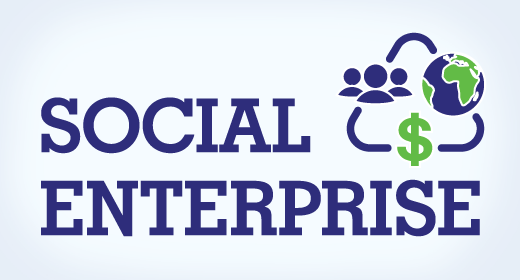
Mapping the New Economy: Social Enterprise
by Chuck Lynd
Social enterprise, sometimes called social entrepreneurship, is arguably the most significant component of the emerging New Economy. A major criticism of the current economy is its focus on maximizing profit, often at the expense of investing in employees and with little regard for environmental impacts. While many responsible businesses do invest in their employees and actively promote sustainable practices, social enterprises incorporate doing good into their DNA.
The social purpose is explicit, and can be broadly applied to both nonprofit organizations and for-profit businesses. By incorporating effective business strategies, social enterprises can yield both financial and social returns. It’s a flexible approach: a nonprofit organization can “own” a for-profit business that returns income to the nonprofit. Or a for-profit business can serve a social or environmental purpose from the get-go. In future columns we’ll explore some of the new business models like Benefit or “B-Corporations” and members of the “One Percent for the Planet” project.
Historically, all corporations were chartered by the state to perform a social purpose that meets the needs of its people and communities. However, court decisions over the past 150 years have favored the interests of business owners and shifted the main focus of publicly held companies to prioritize the maximizing of profits for owners and shareholders. The social enterprise movement is to some extent a response to that trend, particularly in creating businesses that address the needs of marginalized people and cleaning up the environment. Businesses that hire recently incarcerated individuals and recycling programs are good examples.
The annual APTE conference at OSU, Alleviating Poverty through Entrepreneurship, is organized by a student group and features social enterprises operating all over the world. In 2014, I recall a presentation by Neil Bellefeuille, who at that time was Founder and CEO of The Paradigm Project, which builds supply chains to consumers at the base of the economic pyramid. I was surprised that his presentation was focused primarily on the history of business, where he made the argument that the social enterprise business model is superior to the shareholder model. Most see the two models as complementary, but perhaps he was prescient? Will social enterprises some day compete for market share with public companies?
This is already happening to a modest extent in Columbus and central Ohio. Let’s say your company or organization needs to have a luncheon catered. You might choose a nearby local restaurant or perhaps an ethnic restaurant that you haven’t yet tried. Or, you might choose Life Care Alliance, a social enterprise that provides a large meals on wheels program serving the local community. Profits from their catering service support their meals on wheels program and other services that align with their mission to “nourish the human spirit.”
Life Care Alliance is one of 80+ social enterprises in central Ohio that have been identified by the Center for Social Enterprise Development, and the number keeps expanding. The Center has compiled a database of these social enterprises and organized them by category: Children/Toys, Clothing/Jewelry, Education, Food/Drink, Health/Medicine, Home/Lawn, Financial/Mortgages, etc. The Center advocates for social entrepreneurs by providing mentoring services and training for those interested in becoming a social enterprise, I recently attended the first “Social Enterprise Festival” held at McFerson park in the Arena District. More than 30 vendors promoted their business and their social purpose accompanied by live music and entertainment.
There’s more! The Center is part of the Community Investment Network of Central Ohio (CINCOhio.com) that provides a suite of services and acts as a primary network for social enterprise activity in Central Ohio. The CINCO Fund, LLC is a for-profit limited liability company with up to 98 member investors who have pooled their money in order to make investments in start-up social enterprises that create jobs and opportunities for under-served populations and provide significant social benefit to Central Ohio.

Central Ohio is lucky to have the leadership of Allen Proctor, the CEO and passionate promoter of social enterprise development through innovative boot camp training, tireless advising, finance workshops, and more to be discovered at cincohio.com. His vision for nonprofits and the relationship of mission to money is outlined in this TEDx talk in 2011. Allen actively blogs on the website and you can find him on LinkedIn, Facebook, and Twitter as well.
I believe the movement to link mission to profit in the formation of diverse social enterprises is a trend that will continue to gain traction in the New Economy. What do you think? Have you done business with a social enterprise? Comments are welcome.

![]() Chuck Lynd serves as the Steering Committee Chair of the Support Our Local Economy (SOLE) Coalition. This and future columns will be posted on the Think Columbus First website. Email Chuck.Lynd@gmail.com. Contact the author: Chuck.Lynd@gmail.com
Chuck Lynd serves as the Steering Committee Chair of the Support Our Local Economy (SOLE) Coalition. This and future columns will be posted on the Think Columbus First website. Email Chuck.Lynd@gmail.com. Contact the author: Chuck.Lynd@gmail.com



